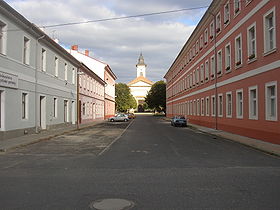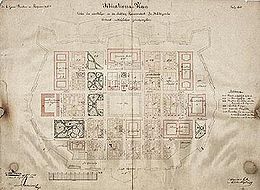- Theresienstadt
-
Terezín
Terezín 
Héraldique
Administration Pays  République tchèque
République tchèqueRégion région d'Ústí nad Labem Province Bohême District Okres Litoměřice Code postal 411 55 Maire Jan Horníček Géographie Latitude Longitude Altitude 176 m Superficie 1 352 ha = 13,52 km² Démographie Population 3 121 hab. (2005) Densité 230,8 hab./ km² Internet Site de la ville www.terezin.cz Terezín (en allemand : Theresienstadt) est le nom d'une ancienne forteresse militaire et ville de garnison de la région d'Ústí nad Labem (Ústecký kraj) en République tchèque.
Sommaire
Histoire
À la fin du XVIIIe siècle, l'Empire d'Autriche érige la forteresse à proximité de la confluence de l'Elbe et de l'Ohře et la baptise Theresienstadt en l'honneur de l'impératrice Marie-Thérèse.
Sa construction commence en 1780 et dure 10 ans. La forteresse couvre une surface totale de 3,89 km², au centre d'une zone inondable. Les fortifications sont conçues dans la tradition de Vauban. En temps de paix, la forteresse accueille une garnison de plus de 5 000 soldats ; en temps de guerre, elle aurait pu accueillir jusqu'à 11 000 soldats. Theresienstadt ne sera cependant jamais utilisée en temps de guerre. Dans la seconde moitié du XIXe siècle, elle servira de prison.
Pendant la Première Guerre mondiale, la forteresse servit de camp de prisonniers. Gavrilo Princip, l'assassin de l'archiduc François-Ferdinand et de sa femme, y fut emprisonné et y mourut de la tuberculose en 1918.
Terezín pendant la Seconde Guerre mondiale
Pendant la Seconde Guerre mondiale, la Gestapo transforma Terezín en camp de concentration, vers lequel environ 144 000 juifs furent déportés. 6000 d'entre eux y périrent, principalement à cause d'atroces conditions de vie (faim, stress, maladies, épidémie de typhus à la fin de la guerre). 88 000 d'entre eux furent déportés à Auschwitz et dans d'autres camps de concentration. À la fin de la guerre, il y avait seulement 19 000 survivants. Robert Desnos, poète français, y est mort du typhus le 8 juin 1945.
Terezín aujourd'hui
Après la guerre, la ville fut rebaptisée Terezín. Elle conserva une garnison jusqu'en 1996, date à laquelle l'armée quitta la ville, causant un impact négatif sur l'économie locale. Terezín continue d'essayer de se détacher de son passé militaire et de devenir une ville moderne et active. Elle a considérablement souffert des inondations en 2002.
Notes et références
Bibliographie
Le Requiem de Terezin, de Josef Bor, Éditions du Sonneur
Liens externes
- Portail de la Tchéquie
Catégorie : Ville de Tchéquie
Wikimedia Foundation. 2010.

